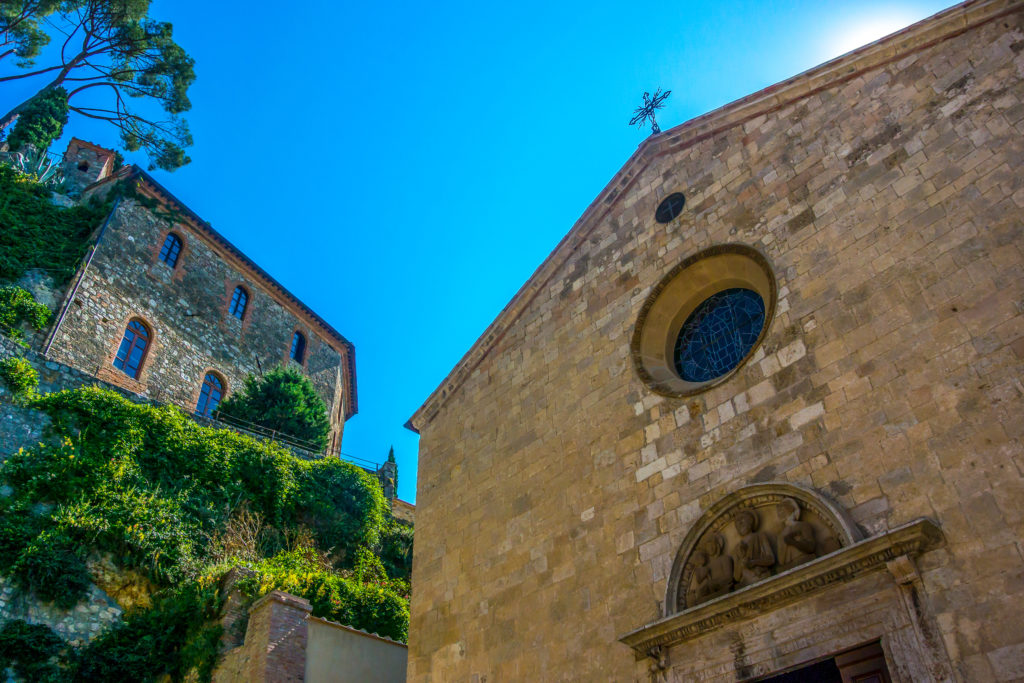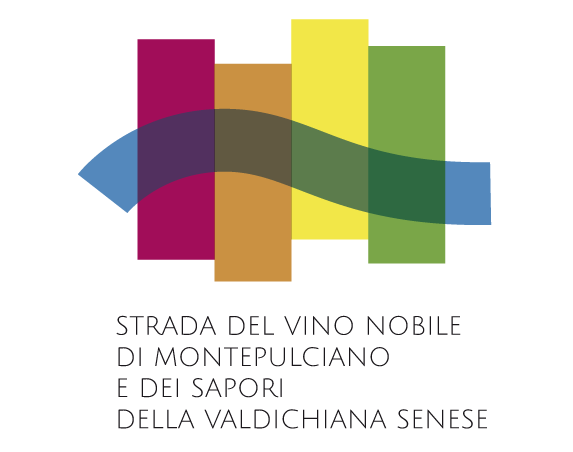
Beauty is everywhere in Valdichiana Senese. We are in the province of Siena, in the southern part of Tuscany, bordering Umbria. To the east we see Cortona, Monte Amiata stands west. We are nine municipalities and we are in the Tuscan countryside, like a postcard.
Imagine winding roads climbing up the hills, hamlets with travertine bricks and Sienese red clay, fields planted with vines and wheat, the Leopoldine (if you don’t know what they are then you just have to follow us…); then add the noise (although actually silence and peace usually surround us), imagine the arrival of a 1950s Vespa, the flow of wine poured into glasses, the typical Tuscan way of speaking; to sight and hearing also add the scent of typical Tuscan cold cuts, imagine the wheat fields burned in Summer and “l’aspro odor dei vini l’anime a rallegrar” (the sour smell of wines to lighten up your soul); finally, imagine the flavour of the best local products and get ready to eat them with us. You are welcome in Valdichiana Senese.
Our territory is beautiful because it is authentic, rural, full of life and tells its millenary history at first glance: from the marine fossils hidden in the underground cellars of Montepulciano to the museum itineraries dedicated to the Etruscan people of Chiusi, Chianciano Terme and Sarteano, from the breathtaking panoramic views that can be seen from the top of historic palaces of the villages to the ancient farmhouses that stand out on top of the hills.
Here you can perceive the strong link with tradition, it is clear that little has changed over the centuries and so it is also for the customs and traditions handed down from father to son, such as peasant recipes and hamlet festivals. Everything is so pure and preserved that it often amazes visitors, captivated by an old-fashioned atmosphere, like in a fairytale.
Here they are our municipalities, we present them to you one by one in all their beauty.
Cetona is a gem, a small hamlet that climbs upon a hill, with its flowers behind houses’ windows and surprising views of the surrounding green hills. Its territory tells how ancient is mankind history through finds that sinking its roots in the Neolithic, you can learn more at the Civic Museum for Prehistory of Monte Cetona: a path for adults and children, immersed in the intense green of the woods of Cetona.
Do we have to talk about food? This Municipality boasts, among others, a very special production: here they produce bico, a particular kind of focaccia (or schiacciata) rigorously without salt according to Tuscan tradition, excellent in combination with tasty Tuscan cheeses and salami.
The 1900s gave a glorious past to this thermal centre known throughout Italy and frequented in the middle of the century by the most important personalities of the time: politicians, writers, actors, show business people all came here from Spring to late Autumn to stroll along the avenues embellished with lime trees. Among others we mention Fellini and Pirandello, just to intrigue you. Speaking the truth, they just weren’t the first to realize that Chianciano Terme is special: the remains of Etruscan settlements preserved in the Waters Museum tell us that Etruscans too, starting from the sixth century B.C. they have been able to exploit the beneficial effects of these thermal waters.
And at table? Chianciano is renowned for a dessert, the Torta di Chianciano to be clear, born in the mid-twentieth century to satisfy the tastes of the Italian vacationers who flocked to the town: are you curious to know this story too? You can find it in our Almanac. Enjoy it!
Destination known for the railway hub Chiusi-Chianciano Terme, Chiusi is above all a pretty town that contains treasures of the Etruscan, Roman and Medieval Times on the surface and in its undergrounds, characterized by museums and catacombs of inestimable cultural and historical value.
Chiusi is particularly lively from a cultural and folkloristic point of view and the cheerful and jovial Chiusi spirit is manifested by the events that populate the city calendar, among all we recommend the food and wine event organized with Slow Food and which involves numerous restaurants belonging to this prestigious Association. Guests are welcome in various structure, small B&Bs in the historic center that surprisingly open up on pretty gardens set between the ancient walls, as well as in country farmhouses where you can breathe the classic Tuscan atmosphere of the past.
Those who live here know that it is worth a stop at the small lake of Chiusi, also known as “Chiaro di Chiusi”, to have lunch with the renowned “brustico”, excellent lake fish cooked on lake reeds. The name comes from the cooking method: “abbrustolito” (roasted), exactly as the Etruscans did.
A Renaissance hamlet but with Etruscan roots, a pearl from the sixteenth century, home of the noblest wine there is (Vino Nobile di Montepulciano), Montepulciano is a village of unique charm. Majestic and at times austere, this is certainly a hamlet to visit with comfortable shoes and a relaxed mood, because the climbs could be hard even for the most trained person. Here the main event is the Bravio delle Botti, which consists in pushing oak barrels of 80kg up the hill and it takes a lot of breath and effort. Ludovica can guarantee this, who in addition to working in Valdichiana Eating has participated in two editions of the event.
And wine, as you can understand, is the real protagonist here. For good. The soil lends itself well to the cultivation of excellent Sangiovese grapes which then become Vino Nobile di Montepulciano DOCG, the first Denomination of Controlled and Guaranteed Origin in Italy, and its wine cellars in some cases are preserved in the surprising undergrounds of the historic center.
Montepulciano is more than the city of Vino Nobile. Here you can taste typical excellent products such as Pecorino di Pienza, Cinta Senese cured meats, saffron, extra virgin olive oil, aglione of Valdichiana, jams and so on.
The name recalls the towers of the hamlet, because this fortification was for a long time a castle subjected to the Sienese domination and the red bricks that cover every building in the historic center demonstrate this, revealing a never hidden affinity to Siena. This village, characterized by textile production and carpentry until the 1970s, today hosts many activities related to agriculture, with attention to organic cultivation.
A few kilometers away you can find Montefollonico, a hamlet that stands proud on the facing hill. As beautiful as Torrita di Siena, Montefollonico offers a glimpse over Valdichiana as far as the eye can see, up to embrace Lake Trasimeno.
The symbolic product of this territory? The Vinsanto. The version of Vinsanto Occhio di Pernice is one of the most renowned so… would you like a drop of vinsanto? It is precisely the evocative name of the event that celebrates the welcoming wine every year in Montefollonico.
We know that Valdichiana Senese’s landscapes are beautiful, but we must underline how beautiful are those that can be seen from San Casciano dei Bagni and from the hamlet of Celle Sul Rigo. The historic buildings in travertine stand out on the hills and ravines, embrace the horizon untill Monte Amiata and to north it seems that Siena can also be reached with your hand. The immensity is in front of us and to enjoy the most of it, the municipal administration has equipped the points of greatest attraction with benches and rest areas.
In San Casciano dei Bagni you must taste Pici, which in Celle sul Rigo are celebrated with a festival that involves all the housewives of the hamlet. The Pici of Celle sul Rigo are famous in the surrounding area, they are served with aglione sauce or Chianina ragù or in a cacio e pepe (cheese and pepper) version. Appiciare (make the pici) is passion! In the hamlet of Palazzone, we recommend you to uncork a good bottle of Chianti Riserva DOCG.
In Sarteano there is a detail that even captured Gucci’s attention: in 2017 the designer used the image of a snake found inside the Tomb of the Infernal Quadriga in Sarteano to dress one of his models. After all, how can you blame them? The colors of this snake are splendid, remained unchanged because it was buried under a hill and found just ten years ago. And if the Tomb and the Etruscan Museum were not enough to tell you the uniqueness and beauty of this far from ordinary Municipality, then have a walk through the alleys of the historic center, climb towards the medieval Castle and enjoy the view that from here opens onto the entire Valdichiana.
The White Giant, the Chianina beef from Valdichiana is the totem animal of Sinalunga. A gigantic, meek and keen long-eyelash animal that can be seen grazing in the fields or in Piazza del Campo in Siena twice a year, for the Palio di Siena. The Chianina is in fact entrusted with the precious task of pulling the carroccio (float) on which the prestigious panno is placed. The fame of Chianina, however, is above all gastronomic: its fine meats are demanded by mote and more people and appreciated for their organoleptic qualities, from the richness of iron to the reduced cholesterol content. Not everyone knows that the Bistecca Fiorentina (Florentine steak) is obtained from Chianina, it is great precisely because it is made from a giant beef. We have the hard task of spreading this news.
In any case, Sinalunga is not only worthy for the Chianina, a visit to the historic center can surprise you for the numerous churches and historic buildings, there is also a theater that is a small jewel. Then, if we move a few kilometers away towards the hamlets of Guazzino, Farnetella and Scrofiano, we find Romanesque churches and sweet views that will continue to amaze you.
When we say “very small villages” we are talking about Trequanda and its hamlets Castelmuzio and Petroio, but the views that can be admired from here over the Valdichiana and Val d’Orcia are just unforgettable.
Loose yourself into the hills, the woods and the olive trees, get fascinated by these landscapes. And the olive trees are the hosts here: in the surrounding area the names of Trequanda, Castelmuzio and Petroio are uniquely recognized as the villages of excellent extra virgin olive oil. This fame from Italy spread abroad up to Japan, where Trequandino oil is particularly appreciated. After all, this landscape has been covering the area for centuries and over time a bit of experience has been gained in the field. We tell you about it in the La Festa dell’Olio Box.
Have you learnt about the beauty of Valdichiana Senese? Please follow us, we have much more to show you …
A narration with the voice of whom everyday lives, eats and cultivates in Valdichiana. You will find this in our newsletter that will follow the seasonality of Valdichiana.
Client support
Valdichiana Eating team answers on Whatsapp at the number +39 3913862801 from Monday to Friday from 9:30 a.m. to 1:30 p.m. and from 2:30 p.m to 6 p.m.
During weekends we are in the countryside to eat!
For tailored requests write us at:
info@valdichianaeating.it
First please take a look at our FAQ section.
VALDICHIANA EATING is a project created by:

Strada del Vino Nobile di Montepulciano
e dei Sapori della Valdichiana
PhotoCredits: Francesco Gorini, Carlo Pellegrini, Celeste Ferrara Credits: WeCaptains